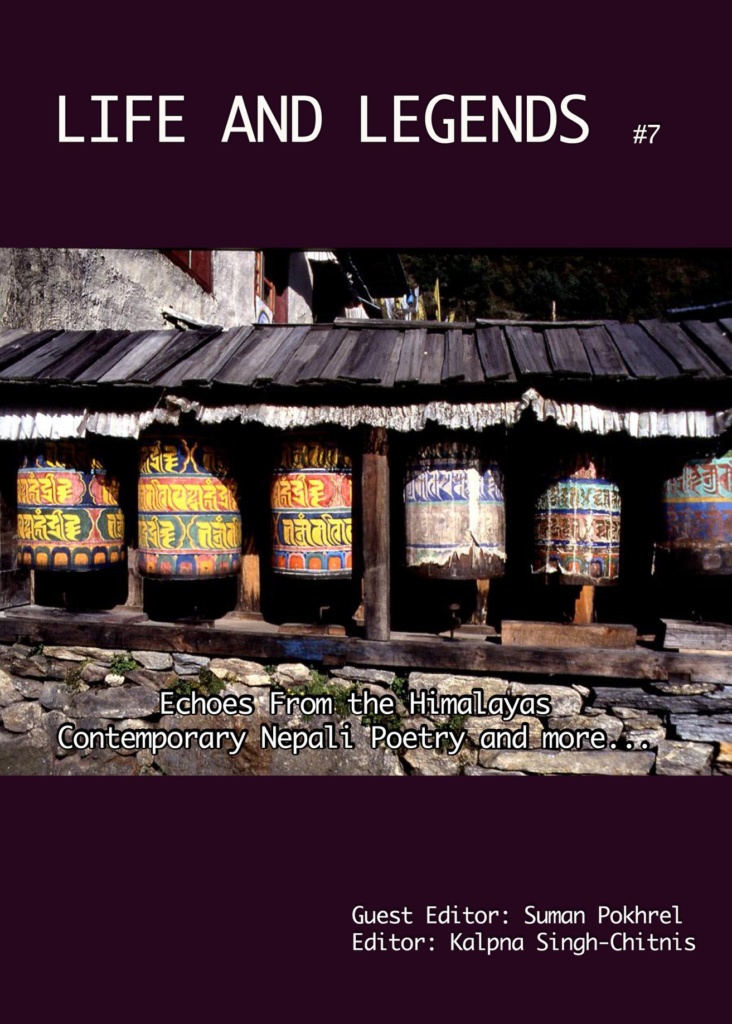 The much awaited seventh edition of Life and Legends with a particular focus on Contemporary Nepali Poetry and all its usual features is here now. The current edition guest edited by Suman Pokhrel brings the original and translated works of twenty six Nepali poets and translators from Nepal, and Nepali poets living in the diaspora.
The much awaited seventh edition of Life and Legends with a particular focus on Contemporary Nepali Poetry and all its usual features is here now. The current edition guest edited by Suman Pokhrel brings the original and translated works of twenty six Nepali poets and translators from Nepal, and Nepali poets living in the diaspora.
Nepali is an Indo Aryan language that finds its roots in the Indo-European language family, written in the Devnagri script, which has evolved from the Brahmi script developed in ancient India.
What best represents Nepali literature is mostly and unapologetically written in the Nepali language, recognized as the country’s official language at the national level. A new generation of Nepali authors and poets writing in English have made their presence felt internationally, however, a vast portion of Nepali literature written in Nepali, and other regional languages of Nepal, is still unavailable to the readers in the Western hemisphere, in want of its translations in English and other European languages.
Therefore, in our continuing effort to discover and recognize international writers writing in their native languages, we are proud to bring the works of many significant Nepali poets, alongside the work of some newer writers in this edition. In their work, they share a glimpse of what is being written in Nepal today, and also, what is being written outside Nepal by the Nepali writers in both English and Nepali. In this mosaic, we find the tradition they follow and also a shift from it at the same time.
The paper written by Dr. Abhi Subedi read at the SARRC Writer’s Summit published in this edition elaborates more on this topic. An interview with him in this issue allows us to learn more about socially, politically and culturally diverse Nepal, that through its art, culture, and literature plays a vital role in finding its identity and democratic values, and also maintaining harmony with its neighboring South Asian countries.
I have not done an in-depth study of all that has been written in modern Nepali poetry, but what I have gathered from reading for this edition and more, that the contemporary Nepali poetry is distinctly original in expressions and carries the very essence of the Himalayan country. There is a freshness in what the Nepali writers are writing, which is now becoming less and less in literature produced in the Indian subcontinent. Politics, war, human misery, social injustice, activism are the themes much in demand in the publishing world today, and although, writings on these subjects does address genuine human concerns, the literature of beauty and esthetic of life is overshadowed by the marketing of such reading materials. Nepali writers, many of them who have seen a feudal society and ten years of bloody civil conflicts in their country (1996-2006), are not entirely immune to the waves of changes and echo similar conflicts and concerns in their work; yet love, hope, and aspirations of a common man are still cardinal themes we encounter in today’s Nepali poetry.
Our regular features in this edition bring the original and translated work of many fine poets and translators from around the world. Our brand new feature Virtual Bookshelf is to share the published work of all writers, who contribute to Life and Legends. This feature is a part of our initiative of building a community of writers and translators around the world and provide exposure to their work.
Last but not least, we want to say thanks to all our contributors for this exceptional edition of Life and Legends. A very special thanks to our guest editor, Suman Pokhrel; without his initiative to bring the Contemporary Nepali Poetry edition of Life and Legends, Echoes from the Himalayas: Contemporary Nepali Poetry and more, would not have been possible.
I hope, you enjoy reading our current edition.
Kalpna Singh-Chitnis
Editor-in-Chief – Life and Legends
April 15th, 2019


